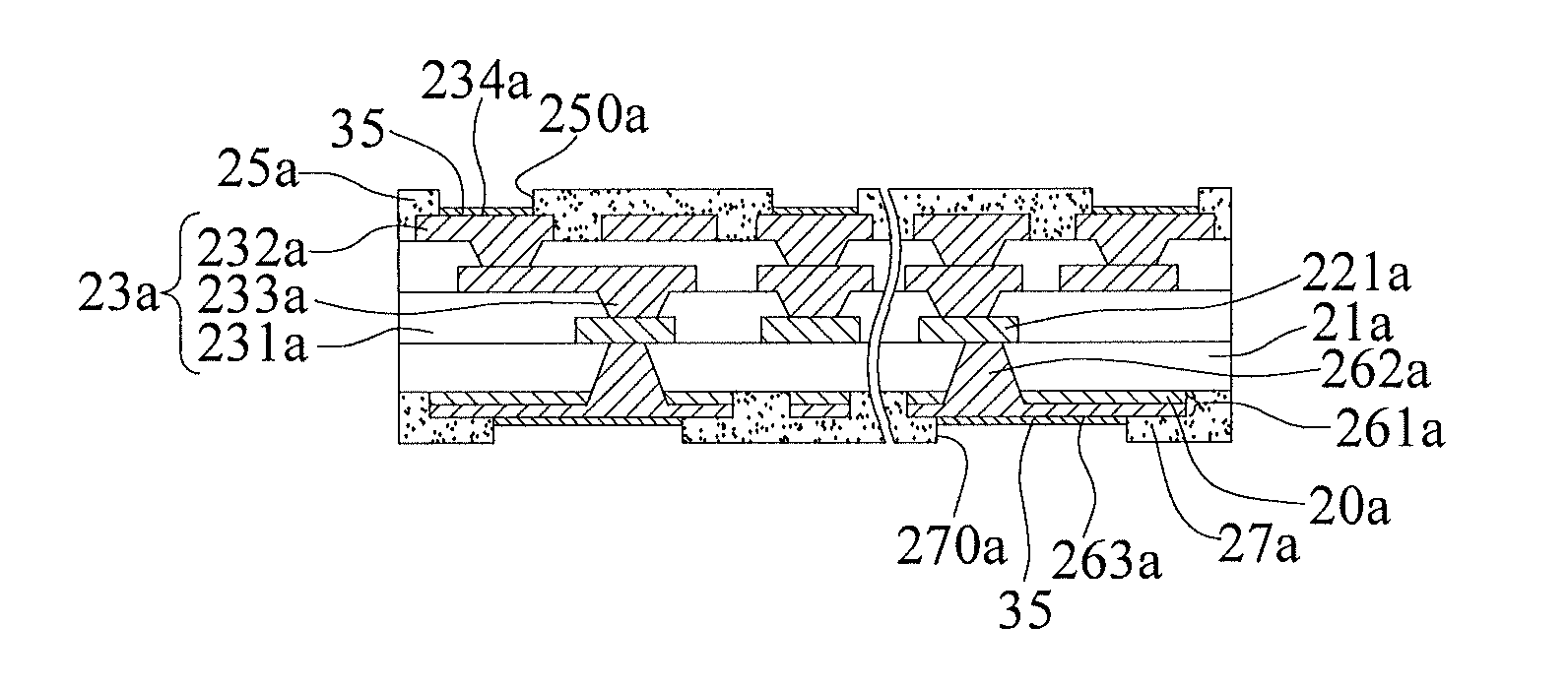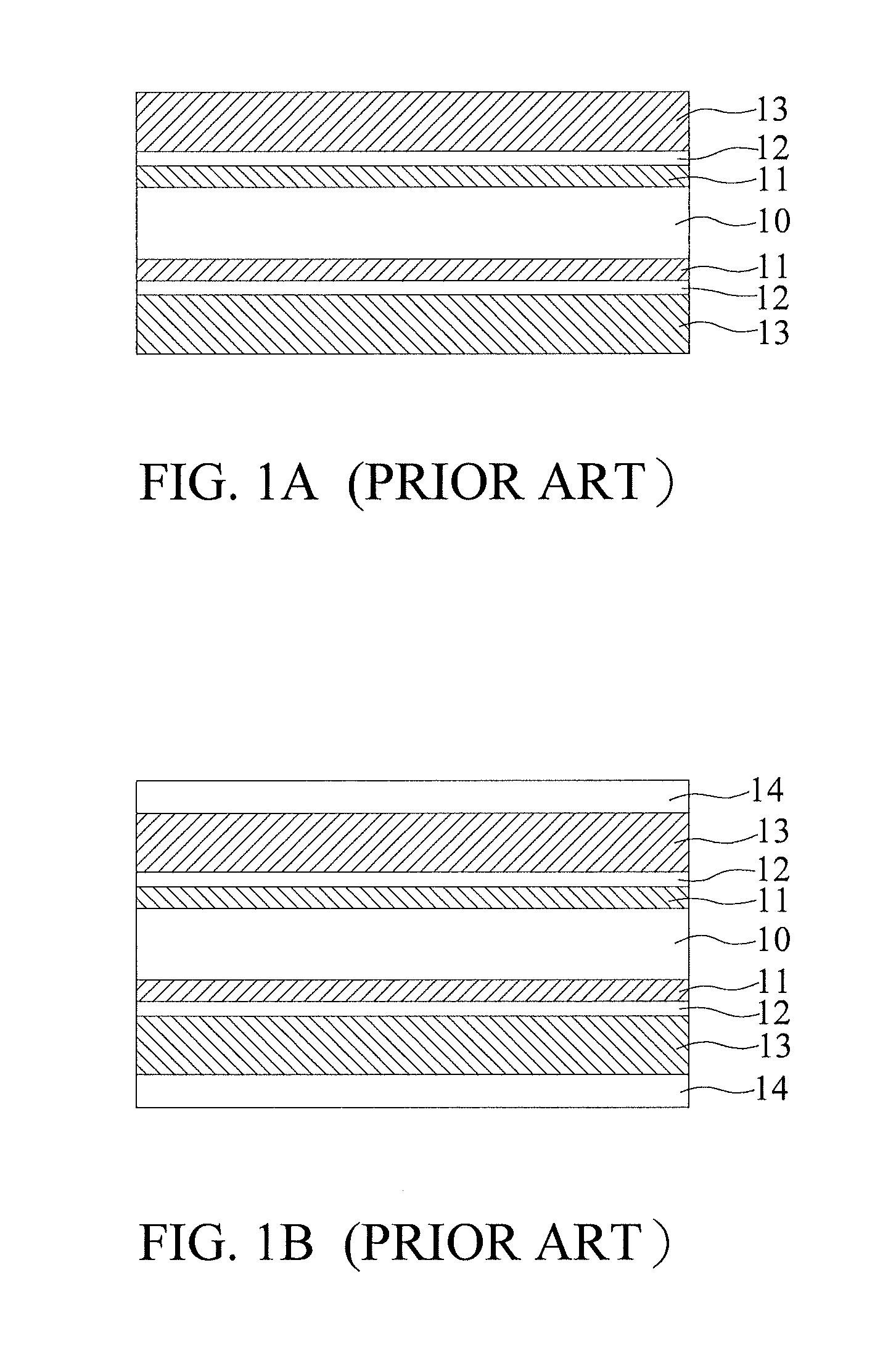Packaging substrate and fabrication method thereof
- Summary
- Abstract
- Description
- Claims
- Application Information
AI Technical Summary
Benefits of technology
Problems solved by technology
Method used
Image
Examples
first embodiment
[0039]FIGS. 2A to 2F are sectional views showing a packaging substrate and a method for fabricating the same according to a first embodiment of the present invention.
[0040]Referring to FIG. 2A, two first metal layers 20a, 20b respectively having first surfaces 201a, 201b and opposite second surfaces 202a, 202b are stacked together with the first surfaces 201a, 201b thereof facing each other; two first assistant dielectric layers 21a, 21b are formed on the second surfaces 202a, 202b of the first metal layers 20a, 20b, respectively; and two second metal layers 22a, 22b are formed on the exposed surfaces of the first assistant dielectric layers 21a, 21b, respectively, which can have a thickness greater than the thickness of the first metal layers 20a, 20b so as to provide sufficient rigidity.
[0041]In the present embodiment, the first surfaces 201a, 201b are smooth surfaces, and the second surfaces 202a, 202b are rough surfaces.
[0042]Referring to FIG. 2B, the first metal layers 20a, 20b...
second embodiment
[0050]FIGS. 3A to 3D are sectional views showing a packaging substrate and a method for fabricating the same according to a second embodiment of the present invention.
[0051]Referring to FIG. 3A, a structure as shown in FIG. 2C is obtained, the first wiring layers 232a, 232b disposed on an outermost portion of the built-up structures 23a, 23b have a plurality of first conductive pads 234a, 234b, respectively. First insulating protective layers 25a, 25b, such as solder mask layers, are formed on the outmost layers of the built-up structures 23a, 23b. A plurality of openings 250a, 250b corresponding in position to the first conductive pads 234a, 234b, respectively, are formed in the first insulating protective layers 25a, 25b so as for the first conductive pads 234a, 234b to be exposed from the first insulating protective layers 25a, 25b.
[0052]Referring to FIG. 3B, the overall structure is cut along cutting edges 24 passing through the first metal layers 20a, 20b.
[0053]Referring to F...
third embodiment
[0055]FIGS. 4A to 4F are sectional views showing a packaging substrate and a method for fabricating the same according to a third embodiment of the present invention, wherein FIGS. 4E′ and 4F′ show another embodiment of FIGS. 4E and 4F.
[0056]Referring to FIG. 4A, a structure as shown in FIG. 2B is obtained, and the second metal layers 22a, 22b are patterned so as to form inner wiring layers 301a, 301b. A plurality of inner conductive vias 302a, 302b are formed in the first assistant dielectric layers 21a, 21b to electrically connect the inner wiring layers 301a, 301b and the first metal layers 20a, 20b. The built-up structures 23a, 23b are formed on the first assistant dielectric layers 21a, 21b and inner wiring layers 301a, 301b. The built-up structures 23a, 23b at least comprise first dielectric layers 231a, 231b, first wiring layers 232a, 232b formed on the first dielectric layers 231a, 231b, and a plurality of first conductive vias 233a, 233b formed in the first dielectric layer...
PUM
| Property | Measurement | Unit |
|---|---|---|
| Time | aaaaa | aaaaa |
| Electrical conductor | aaaaa | aaaaa |
Abstract
Description
Claims
Application Information
 Login to View More
Login to View More - R&D
- Intellectual Property
- Life Sciences
- Materials
- Tech Scout
- Unparalleled Data Quality
- Higher Quality Content
- 60% Fewer Hallucinations
Browse by: Latest US Patents, China's latest patents, Technical Efficacy Thesaurus, Application Domain, Technology Topic, Popular Technical Reports.
© 2025 PatSnap. All rights reserved.Legal|Privacy policy|Modern Slavery Act Transparency Statement|Sitemap|About US| Contact US: help@patsnap.com



